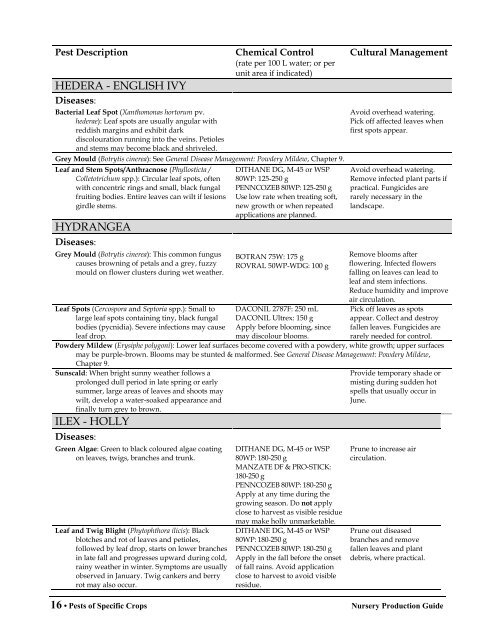You also want an ePaper? Increase the reach of your titles
YUMPU automatically turns print PDFs into web optimized ePapers that Google loves.
Pest Description<br />
HEDERA - ENGLISH IVY<br />
Chemical Control<br />
(rate per 100 L water; or per<br />
unit area if indicated)<br />
Diseases:<br />
Bacterial Leaf Spot (Xanthomonas hortorum pv.<br />
hederae): Leaf spots are usually angular with<br />
reddish margins and exhibit dark<br />
discolouration running into the veins. Petioles<br />
and stems may become black and shriveled.<br />
Grey Mould (Botrytis cinerea): See General Disease Management: Powdery Mildew, Chapter 9.<br />
Leaf and Stem Spots/Anthracnose (Phyllosticta /<br />
Colletotrichum spp.): Circular leaf spots, <strong>of</strong>ten<br />
with concentric rings and small, black fungal<br />
fruiting bodies. Entire leaves can wilt if lesions<br />
girdle stems.<br />
HYDRANGEA<br />
Diseases:<br />
Grey Mould (Botrytis cinerea): This common fungus<br />
causes browning <strong>of</strong> petals and a grey, fuzzy<br />
mould on flower clusters during wet weather.<br />
Leaf Spots (Cercospora and Septoria spp.): Small to<br />
large leaf spots containing tiny, black fungal<br />
bodies (pycnidia). Severe infections may cause<br />
leaf drop.<br />
DITHANE DG, M-45 or WSP<br />
80WP: 125-250 g<br />
PENNCOZEB 80WP: 125-250 g<br />
Use low rate when treating s<strong>of</strong>t,<br />
new growth or when repeated<br />
applications are planned.<br />
BOTRAN 75W: 175 g<br />
ROVRAL 50WP-WDG: 100 g<br />
DACONIL 2787F: 250 mL<br />
DACONIL Ultrex: 150 g<br />
Apply before blooming, since<br />
may discolour blooms.<br />
Cultural Management<br />
Avoid overhead watering.<br />
Pick <strong>of</strong>f affected leaves when<br />
first spots appear.<br />
Avoid overhead watering.<br />
Remove infected plant parts if<br />
practical. Fungicides are<br />
rarely necessary in the<br />
landscape.<br />
Remove blooms after<br />
flowering. Infected flowers<br />
falling on leaves can lead to<br />
leaf and stem infections.<br />
Reduce humidity and improve<br />
air circulation.<br />
Pick <strong>of</strong>f leaves as spots<br />
appear. Collect and destroy<br />
fallen leaves. Fungicides are<br />
rarely needed for control.<br />
Powdery Mildew (Erysiphe polygoni): Lower leaf surfaces become covered with a powdery, white growth; upper surfaces<br />
may be purple-brown. Blooms may be stunted & malformed. See General Disease Management: Powdery Mildew,<br />
Chapter 9.<br />
Sunscald: When bright sunny weather follows a<br />
prolonged dull period in late spring or early<br />
summer, large areas <strong>of</strong> leaves and shoots may<br />
wilt, develop a water-soaked appearance and<br />
finally turn grey to brown.<br />
ILEX - HOLLY<br />
Diseases:<br />
Green Algae: Green to black coloured algae coating<br />
on leaves, twigs, branches and trunk.<br />
Leaf and Twig Blight (Phytophthora ilicis): Black<br />
blotches and rot <strong>of</strong> leaves and petioles,<br />
followed by leaf drop, starts on lower branches<br />
in late fall and progresses upward during cold,<br />
rainy weather in winter. Symptoms are usually<br />
observed in January. Twig cankers and berry<br />
rot may also occur.<br />
DITHANE DG, M-45 or WSP<br />
80WP: 180-250 g<br />
MANZATE DF & PRO-STICK:<br />
180-250 g<br />
PENNCOZEB 80WP: 180-250 g<br />
Apply at any time during the<br />
growing season. Do not apply<br />
close to harvest as visible residue<br />
may make holly unmarketable.<br />
DITHANE DG, M-45 or WSP<br />
80WP: 180-250 g<br />
PENNCOZEB 80WP: 180-250 g<br />
Apply in the fall before the onset<br />
<strong>of</strong> fall rains. Avoid application<br />
close to harvest to avoid visible<br />
residue.<br />
Provide temporary shade or<br />
misting during sudden hot<br />
spells that usually occur in<br />
June.<br />
Prune to increase air<br />
circulation.<br />
Prune out diseased<br />
branches and remove<br />
fallen leaves and plant<br />
debris, where practical.<br />
16 • <strong>Pests</strong> <strong>of</strong> <strong>Specific</strong> <strong>Crops</strong> Nursery Production Guide
















